THE SINGLETON SILK MILL, WADESBORO, NC 1888 - 1927
There has been several excellent published articles documenting the history of the
Singleton Silk Mill Mfg. Co. located here in Wadesboro, NC, circa 1888 - 1927 written
by the following:
TD Burns of Charlotte, NC,
Steve Bailey, local Genealogist and Mary
Medley in her book
The History of Anson County 1750 - 1976,
whereas historically, there is very little to add to their writings.
This was the
first silk mill in North Carolina and the
first silk mill in the South if you
go by their date of incorporation.
However, I am going to give a recap of the Singleton Silk Mill's history
including hyperlinks of land purchases; e.g., deeds, land plat images not
documented before, newspaper articles, photos and information from Sally
Smith of Berlin, MD, granddaughter of Charles and Sarah Uren, last
Superintendent of the Singleton Silk Mill and a personal account of information
passed to me from my Grandma Della Coley who worked there from 1902 at age 8 until
1919 when she married my Grandpa Jesse McKnight "Mack" Coley on August 21, 1919.
DEED HISTORY INFORMATION
The Singleton Silk Mill was located on property know as Carr's Mount
consisting of thirty-four (34) acres, more or less of which 9.15 acres is currently
occupied by The Wadesboro Housing Authority and a large water tank and the
balance of the original track belonging to Dunlap & Mills, Inc.
Prior to that and going back to February 23, 1872, said property was
conveyed from K. H. Strong to John Williamson
Deed Book
16 Page 625,
and said Williamson to Nathaniel A. Knight by Deed Book bearing date
February 23, 1872 which is registered in
Deed Book 18 Page 201 and by said
Knight to James T. Bradley by deed bearing date July 19, 1876 and registered
in
Deed
Book 20 page 334 and on May 1, 1879, land was deeded from James
T. Bradley and his wife Emma A. Bradley to the Dixie Agricultural and
Mechanical Association for $ 1,250.00 dollars registered in Deed Book 21
Pages
635 and
636. Property was used as a fair
grounds and hosted other local events; e.g. circus/carnival and used as a
race track.
DEMISE OF THE DIXIE FAIR GROUNDS
Below is a transcript of the sale of the Carr's Mount property listed in
Anson Times February 16, 1882 page 3 as follows: Sale of Valuable Property.
By virtue of powers conferred upon me as Trustee and contained in a Deed of
Trust, executed on 2nd day of May A. D., 1879, by the Dixie Agricultural and
Mechanical Association to James T. Bradley, and registered in Trust Book No.
14, pages 86 and 87 in the office of Register of Deeds of Anson County, I
will sell to the highest bidder, for cash, at the Court House door, in
Wadesboro, North Carolina, on the 5th day of June 1882, a lot or parcel of
land just without the corporate limits of said town of Wadesboro, known as
the "Carr's Mount place," and containing Thirty-Four (34) acres. The sale of
the above described property will be had to realize the purchase money due
thereon and now past due. Title warranted. For further information apply to:
James T. Bradley, Trustee, Wadesboro, N. C. Feb. 4th 1882.
Open this
hyperlink to view a copy of land Plat Book 1 Page 48 done by Gray
& Son which shows the Dixie Fair Ground in the upper left hand section of
the map. NOTE: There are practically no structures shown between the
Dixie Fair Ground going South West to Salisbury Road, now called Salisbury
Street. Use your view feature on Adobe to rotate the image as viewed
in your browserCARR'S MOUNT PROPERTY TO SINGLETON SILK MILL INVESTORS;
SINGLETON, ROSE AND MURRAY
George Singleton of Morris County, State of New Jersey, Ebenezer K. Rose of
Passaic County, New Jersey and Russell Murray of New York County in the
State of New York formed a North Carolina Corporation called
Wadesboro Manufacturing Company on May 1,
1888, for the purpose of manufacturing silk, whereas the amount of capital stock was six thousand (6,000) dollars
with a total of sixty (60) shares at one hundred (100) dollars each and each
owning 1/3 of the stock. George Singleton and his brother Robert were already
in the silk business and one does wonder why Wadesboro was chosen for the
location of his new mill.
Carr's Mount property was ultimately transferred on December 29, 1890 to
George Singleton of Dover, New Jersey, Ebenezer Rose of Passaic, New Jersey
and Russell Murray of New York by James T. Bradley who was the Trustee of
the Carr's Mount property recorded in Deed Book 28 Pages
221,
222,
223
and 224. As stated above, they formed a corporation known
as the Wadesboro Manufacturing Company, not connected to our current Wade
Manufacturing Company. John T. Patrick is credited with getting the
investors to locate a silk mill here in Anson County. You can read about the
life of John T. Patrick at this
link:
The above three investors, George Singleton, Ebenezer Rose, Russell Murray
and their wives sold the Carr's Mount land consisting of thirty-four (34)
acres to the Wadesboro Manufacturing Company for one (1) dollar and other
valuable considerations on December 28, 1899 recorded in Deed Book 34 Pages
20 Page
21 and Page
22.
George Singleton, President and Russell Murray, Secretary of the Wadesboro
Manufacturing Co. (Silk Mill owners) deeded 1/4 acre of land to the
Wadesboro White Baptist Church "Trustees" on April 30, 1906 recorded in
Deed
Book 4 Pages 126 and 127.
On December 23, 1920, George Singleton and Russell Murray, Surviving
Directors and Trustees of the Wadesboro Manufacturing Company, whereas their
thirty (30) year corporate existence had expired, sold their interests to
The Singleton Silk Mill Manufacturing Company recorded in Deed Book 59 Pages
194 and
195. George Singleton was the
President of the Singleton Silk Mill.
George Singleton invested heavily into property and housing here in
Wadesboro for the silk mill employees, whereas my Grandpa Jesse McKnight
'Mack" Coley purchased a considerable amount of houses and lots known as the
West Side Extension of which was an entire "Mill Village" that was owned by
George Singleton per the
1915 Plat Book 1 Page 37 and deeded to him
on March 9, 1921 from the Anson Real Estate and Insurance Company documented
in
Deed Book 59 Pages 261 and 262. Most of the
George Singleton properties were sold to the Anson Real Estate and Insurance
Company beginning in 1915. George Singleton released the title to land to
the Anson Real Estate and Insurance Company recorded in
Deed Book 57 Page 347 on December 20, 1919.
GEORGE SINGLETON - INVENTOR
George Singleton was also an inventor, whereas he was issued US Patent
No. 340,631 on April 27, 1886 for a tension device for silk spinning
machines. I have two images hyperlinked for
Figure 1 and
Figure 3 which shows the device.
Patent application was filed in the US Patent Office on May 19, 1884 and
takes about the same amount of time today to get a patent issued.
George Singleton was born on December 20, 1843 and died on January 28,
1931. He was married to Abigail Condict who was born on April 9, 1856
and died on January 1, 1936. Both are
buried at the Orchard Street Cemetery in
Dover, Morris County, New Jersey.
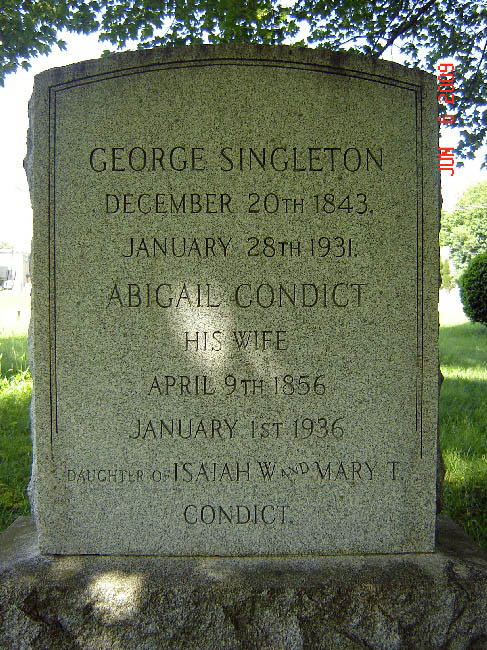
ROBERT SINGLETON, SUPERINTENDENT 1890 - 1905
Robert Singleton, the brother of George Singleton
married Mary Dabbs of
Anson County on December 24, 1888 at the Episcopal Church here in Wadesboro,
whereas Robert was 41 years old and Mary was 22 years old. Robert
Singleton was the superintendent of the Singleton Silk Mill and kept
that position until sometime after 1905 when he was replaced by Charles C. Uren.
Robert deeded his wife Mary E. Singleton 10 acres of land on December 21,
1902 recorded in
Deed Book 35 Page 582. Mary Singleton
sold tracks of land to the Anson Real Estate and Insurance Company on
September 21, 1915 recorded in Deed Book 52
Page
335 and
336 with
the exception of a 1.6 acre track of land. Robert
Singleton sold off several parcels of land recorded in
Deed Book 44 Page 461, whereas he sold 1.6 acres of
land adjacent Salisbury Street to The Singleton Silk Mill Manufacturing
Company on April 10, 1908 which was the Colored Silk Mill, Plant # 2. Robert Singleton went to Augusta, Georgia
to manage the silk mill there until his death.
THE SILK MILL WILL DOUBLE ITS CAPACITY
According to published information in the Messenger and Intelligence
article dated October 28, 1897, quote, "The Silk Mill Will Double Its
Capacity. Enough machinery to double the capacity of the Wadesboro
Silk Mill is now being received at the mill. Mr. Robert Singleton, the
efficient superintendent, says the mill is doing well now. About 80
operatives will be required to run the mill after the new machinery is
placed."
HYPERLINKED NEWSPAPER ARTICLES ABOUT THE SINGLETON SILK
MILL - DONATED BY STEVE BAILEY TO THE HAMPTON ALLEN LIBRARY GENEALOGY ROOM
Anson Times February 16, 1882 Page 3
Anson Times May 4, 1882 Page 3
Anson Times February 16, 1882 Page 3 copy 2
M & I
September 27, 1894
M & I
October 28, 1897 Page 3
M & I
March 3, 1904 Page 3
M & I
June 30, 1904 Page 3
M & I May
25, 1905 Page 3
M & I May
24, 1906 Page 5
M & I
January 24, 1907 Page 1
M & I
October 24, 1907 Page 1
M & I
November 7, 1907 Page 1
M & I
December 24, 1908 Page 5
M & I
July 10, 1913 Page 1
M & I May
28, 1925 Page 5
M & I
January 6, 1927 Page 5
M & I
April 5, 1928 Page 7
M & I
June 21, 1928 Page 1
The above article hyperlinks from the Anson Times
and The Messenger and Intelligence are a good time line of the
goals of George Singleton for his Silk Mill here in Wadesboro, NC and his
influence and impact on the economy of Wadesboro. George Singleton had
some novel and unique ideas implemented about helping his employees to get
educated, (night school), learn other skills and crafts and provide
recreation for them, whereas a couple of the newspaper articles hyperlinked
above go into more detail.
ROBERT SINGLETON OBITUARY NOTICE
The following obituary notice was placed in the Messenger and Intelligence
on July 10, 1913 Page 1 as follows:
"Mr. Robert Singleton died
yesterday morning at his home in Augusta, Ga., after an illness for several
weeks. The funeral was held in Augusta today.
Mr. Singleton was well known and had many friends in Wadesboro, he having
had charge of the silk mill here until about six years ago, when he moved to
Augusta to take charge of a mill there. He married Miss Mollie Dabbs,
of Anson and survived by his wife and by six children: Messrs Sam, Russell,
James, Robbie and May Singleton."
Robert Singleton is
buried in the Magnolia Cemetery in Augusta,
Georgia. Mary Dabbs Singleton, Robert's wife died on January 15, 1928
and is
buried in the Singleton plot in the
Magnolia Cemetery in Augusta, Georgia along with several of their children.
CHARLES C. UREN, SUPERINTENDENT 1905 - 1927
Charles C. Uren married a local woman Sarah H. Flake on September 15, 1905,
whereas they have her fist name spelled Sallie on the
marriage license and remained here in
Wadesboro after the closing of the Singleton Silk Mill sometime after 1927.
Charles and Sarah had three daughters; Daisy Ruth, Louise Crane and Rachel
Marietta.
Sarah was the bookkeeper for the silk mill
during this time. Below is a picture of a picture of their wedding photo
courtesy of Sally Smith, Berlin, MD their granddaughter:

Charles and Sara lived in the Superintendents house located on the
Singleton Silk Mill property until the mill was closed sometime in 1927.
During the time while living at the Superintendents home at the
Singleton Silk Mill, they had three lovely daughters. From left to right;
Daisy Ruth, Rachel Marietta and Louise Crane; photo courtesy of Sally Smith,
daughter of Daisy Ruth. The Uren family later moved into
the home purchased at 411 Leak Avenue.

Sara aka Sallie Uren purchased lots 12, 13, 31, 32 adjoining one another
located between Leak Avenue and Park Avenue here in Wadesboro, NC on May 21,
1927 from T. L. Huntley recorded in Deed Book 68 Page
429
and Page
430.
Charles C. Uren and his wife Sarah aka Sallie H. Uren owned a good amount of property
in Anson County of which they started selling their land investments off as
of May 29, 1920, no doubt experiencing a decline in the silk business
brought about by several factors mentioned in
TD Burns article.
Charles and Sarah Uren sold three (3) lots to the Anson Real Estate and
Insurance Company on April 3, 1926 recorded in
Deed Book 66 Page 198. Sallie H. and
Charles C. Uren sold T. L. Huntley 83 3/4 acres of land on May 21, 1927
recorded in
Deed Book 67 Page 525. On July 31,
1946, Charles C. and Sallie H. Uren sold lot No. 3 to Edward R. Little
recorded in
Deed Book 148 Page 336
Plat Book 1
Page 71 and Lot No. 4 to G. K. Little recorded in
Deed Book 101 Page 560
Plat Book 1
Page 71. On April 20, 1942, Charles C. & Sarah H. Uren sold
a lot in Peachland adjacent the U.S. Post Office to J. R. Crowder recorded
in Deed
Book 91 Page 601 shown on
Plat 1 Page 14.
On December 20, 1956, Sallie Uren is listed as a widow
and living in Fairfax, Virginia and sold the four (4) lots to Demps K. and Frankie Sipe
Moose recorded in
Deed Book 122 Page 532. The four lots
in the last Deed reference are abutting one another and go from Leak Avenue
to Park Avenue here in Wadesboro, NC and are shown on
Plat Book1
Page 25 and
Plat Book 1 Page 76.
On
February 23, 1960 said lots were sold to James D.
Redfearn and wife, Ruth Lowery Redfearn recorded in
Deed Book
137 Page 119. On January 29, 1996 said property was deeded
to Clara Lowry, Executrix of the Estate of Ruth L. Redfearn recorded in
Deed
Book 378 Page 170 upon the death of her Sister Ruth of which James and Ruth
Redfearn didn't have any children. Upon the death of Miss Clara Lowry,
the property was sold to BK Staton LLC recorded in
Deed Book
859 Page 359 by Mark T. Lowe the Executor of the Estate of Clara
Lowry on November 7, 2007. Miss Clara left considerable funds to Duke
University and Elon University as Miss Clara was never married and the last
of the Lowry Klan. The
street address for the above property is 411 Leak Avenue. The original long
handle well pump sits atop the well casing and a concrete slab near the home
which definitely was used before city wide water was available. Below
are current pixs of the home and the long handle well pump appears to
be broken or partly disassembled.
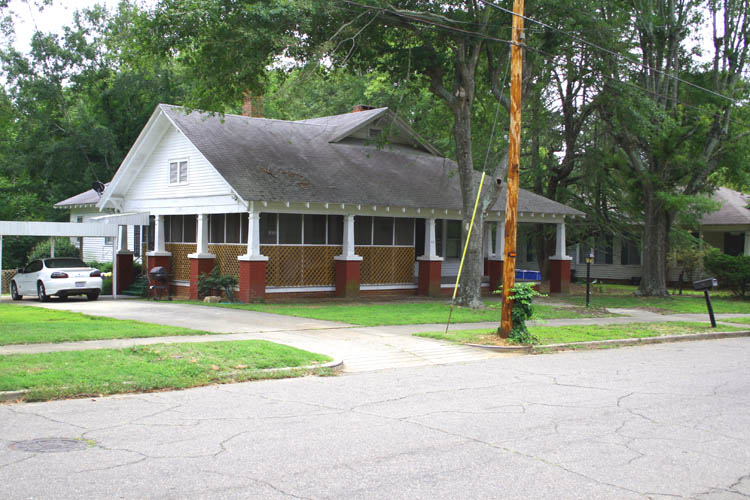
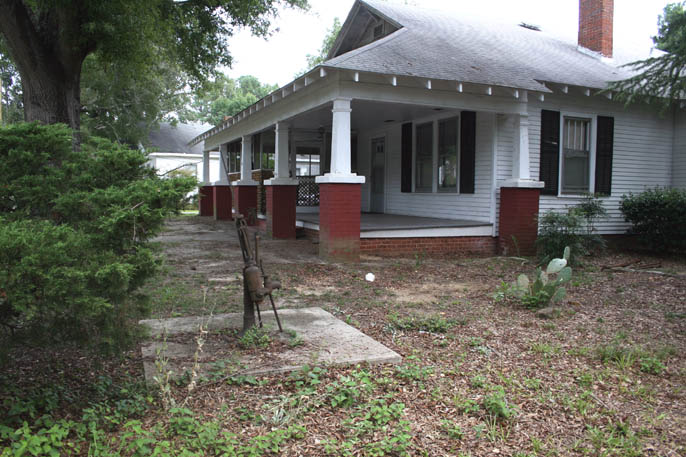
My bride and several other care givers helped look after Miss
Clara Lowry,
an elderly Lady who lived in this home until her death in 2007. The home
was left to Miss
Clara by her Sister Ruth Redfearn referenced above and it
is sad
that no one in
Clara Lowry's immediate family had any children.
The front and side wrap around porch is one of the things my bride loved
most about this home. The house was well built for its time and had
quality materials that went into its construction. I have
personally been in this home and listened to Miss Clara play her keyboard of
which she was very musically talented playing several different instruments
by ear. Pix of
Clara at our Halloween Party taken in 2004
and pix of
Clara taken on 11-24-05.
To reiterate, none of Clara's Brothers or Sisters had any children.
I have the 1940 Census Report for Charles and Sarah Uren hyperlinked
here. According to Sally R. Smith,
their granddaughter, her grandparents lived a quiet retirement life at their
home at 411 Leak Avenue here in Wadesboro, NC.
Charles C. Uren and his wife Sarah F. Uren are buried in the Eastview
Cemetery here in Wadesboro.
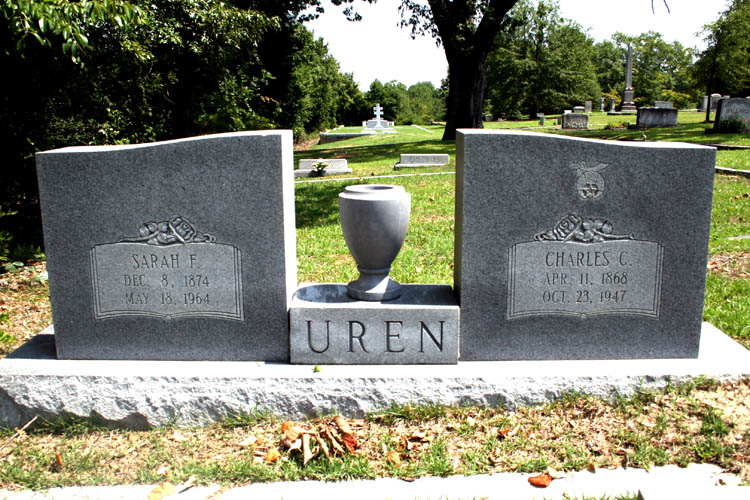
Two of the Daughters of Charles and Sarah Uren are also buried in the
Eastview Cemetery;
Louise Crane Uren Brigman died on April
30, 1997 and and
Rachel Marietta Uren Lawson died on October
15, 1987 and her husband
John Patrick Lawson who died on September
6, 1968. Daisy Ruth Uren Rosenberger and Clyde Kenneth Rosenberger are
buried in Manassas, Virginia.
CLOSING OF THE SINGLETON SILK MANUFACTURING COMPANY
The Messenger and Intelligence on
January 6, 1927 page 5 reported that Mr.
Charles Uren, manager of the silk mill, has received instructions from the
head office of the Singleton Silk Manufacturing Co. to close the mill down
indefinitely, only a watchman being retained. The closing of the mill
was brought about by several factors mentioned by other writers; e.g., the
trade interruption caused by WWI, some of the original Investors had died
and the rest were of advanced age, Tuberculosis outbreak at the mill,
whereas several employees had died and a decline in the demand for silk.
This was definitely a set-back to the hundreds of people employed at the
silk mill who depended on a regular paycheck just to survive. Entire
families were employed at the silk mill and The Great Depression was right
around the corner. Wages varied from about 5 dollars to 20 dollars per
month depending on the specific job and of course the children employed
didn't receive the same amount of wages as did the adults according to
verbal information received from individuals that worked there and/or their
family members.
SINGLETON SILK
MILL PLANT # 2 FOR PEOPLE OF COLOR
Other than newspaper articles written, I don't know of anyone left to
interview concerning Plant # 2 that was built just for
people of color and never heard my Grandma Coley make
mention of it. That era was definitely a time of extreme segregation. On
09-27-15, I noticed on the 1915 plat of the West Side Extension Property
owned by George Singleton recorded in
Plat Book 1 Page 37, there is a building
symbol with the annotation Silk Mill
and now we know where the location of the Silk Mill for people of color was
located per the newspaper accounts of its construction and location which
was not specific. The ole cliché, "You
can't see the forest for the trees" applies to myself on this
late observation since the information was right under my nose the entire
time!
ERECTION OF COLORED SILK MILL
Here is a transcript of the
Messenger and Intelligence article dated
May 25, 1905 page 3. "The Wadesboro Manufacturing Company, the
corporate name of the concern that owns and operates the Wadesboro silk
mill, of which Mr. George Singleton of New Jersey is the lessee, has
perfected arrangements for the erection of another large mill here.
The mill will be located just outside of town on the right hand side of the
Salisbury road and will be operated exclusively with colored labor.
Mr. W. T. Brasington has the contract for the erection of a large frame
building in which silk spinning machinery will be installed for the purpose
of instructing colored boys and girls in its use, to the end that they may
become efficient operatives by the time the mill proper is finished.
The permanent mill will be built of brick and will be 200 feet long by 45
feet broad. The frame building is to be erected at once and is hoped
to have the entire plant in operation by the first of January next.
The location of the mill is an ideal one when it is considered that only
colored help to be employed as that section of the town is inhabited
exclusively by colored people. The mill while it will belong to the
same parties who own the present mill here, will be operated on an entirely
independent basis and the help in the two mills will not in any way come in
contact with each other.
The only
silk mill in this country that has been
successfully operated with colored labor is located at Fayetteville, this
State. The mill has been in operation several years and it has been
demonstrated that colored boys and girls under proper restrictions can be
developed into fairly good operatives. Mr. Robert Singleton,
superintendent of the mill here has made a study of the management of the
Fayetteville mill and it is his purpose to conduct the mill here along the
lines that have made that mill a success.
The mill when completed, will give employment to from 150 to 200
operatives."
COLORED SILK MILL DEED HISTORY TO DATE
I found Deed Book 53 Page
69
and Page 70
dated September 20, 1915 that detailed the sale of a parcel of land adjacent
to Salisbury Street with the exception
of 1.35 acres of land and reserved
which fully described the silk mill for colored people as shown on the West
Side Extension
Plat Book 1 Page 37 with the meets and
bounds listed adjacent the individual lots on said plat dated July 1915.
On
09-30-15, I searched through the Grantor and Grantee Index records at the
Register of Deeds Office here in Wadesboro, NC and located deed transfers of
the Plant # 2 property, whereas George Singleton sold the land and buildings
to Anson Real Estate & Insurance Company on May 12, 1926 recorded in
Deed Book 66
Page 367
and Page
368, whereas on Page 368 it states
"said party of the first part has
operated a Silk Mill which was run by the use of colored labor, said
property being known as the Colored Silk Mill property."
On July 7,
1928 said property was sold by the Anson Real Estate & Insurance
Co. to B. J.
Dargan recorded in Deed Book 69 Page
367
and Page
368.
On April 1,
1939, said property was sold by Paul J. Kiker, Trustee to Thomas Kluttz,
Trustee, ET AL of Kesler's Chapel, A.M.E. Zion Church of Wadesboro, NC
recorded in Deed Book 84 Page
154
and Page
155.
Sally
Smith, Granddaughter of Charles Uren, the last Superintendent of the
Singleton Silk Mill related to me "that according to verbal information from
her Father, Charles Uren her Grandfather would deliver the weekly payroll by
going down the hill through the woods in route to the
"colored silk
mill."
In all probability he would take the shortest route which would be accessing
Maple Lane and walking down to Catherine Lane which did not extend all the
way to Mill Street and was a well worn path even back in the middle to late
1950s. Catherine Lane was later extended all the way to Salisbury
Street and Mill Street was later named Silk Mill Street and Ingram Street.
Plat Book 1 Page 37
survey in 1915 of George Singleton's West Side Extension properties shows the location of the colored silk along with the older
street names. Several references have used the term; e.g.,
"at the foot of
the hill"
describing the location of the "colored silk mill" of which many in the past
were thinking it was located in front of the Singleton Silk Mill there
adjacent to Sikes Avenue which is incorrect. It is easy to see why
that description was used since the Singleton Silk Mill location off Sikes
Avenue is definitely elevated in relationship to where the colored silk mill
was located adjacent Salisbury Street.
SATELLITE VIEW OF COLORED SILK MILL PROPERTY 2010
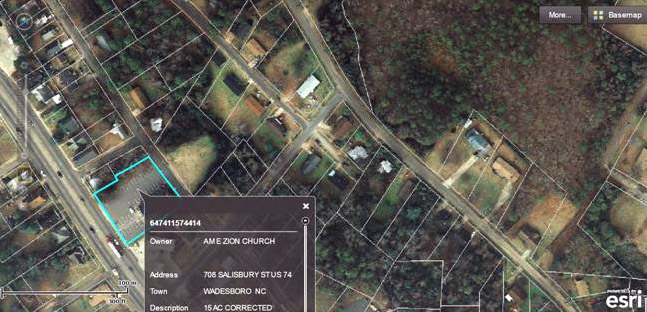
Above
2010 satellite image of the colored silk mill property that is owned by the
AME ZION CHURCH. The vacant lot to the rear of the Church is also part
of the original property that the silk mill was on. Ingram Street now
cuts through the center of the property that the colored silk mill was
located at.
1915 PLAT BOOK 1 PAGE 37 WEST SIDE EXTENSION

Above is a copy of Plat Book 1 Page 37 of the
property of George Singleton called West Side Extension
circa 1915 which was the Singleton Silk Mill village at the time. The colored
silk mill is depicted in the lower left section of the drawing with
two buildings annotated and the larger building labeled SILK MILL of
which the property is approximately
1.35 acres more or less.
NEW OWNERS OF THE OLD SILK MILL
In the Messenger and Intelligence on
April 5, 1928 page 7, Messrs. H. B.
Allen and W. Henry Liles have bought from the company which formerly
operated the mill the old silk mill property in North Wadesboro, including
the real estate, buildings and machinery. The real estate was traded
for some time ago and this week a deal was closed for the machinery. Messrs.
Allen and Liles have made no announcement as to their plans for the
property, but it is expected that the mill will be in operation before a
great while.
Deed Book 69 Pages 236 & 237 recorded
the land purchase excepting the equipment, etc., on March 1, 1928 from the
Singleton Silk Mill by George Singleton, President.
This is a transcript from the
M & I June 21, 1928. WILL ERECT SILK MILL
MACHINERY. Allen-Liles Silk Company Will Manufacture Silk Hosiery Yarns - To
Be In Operation Soon - Jepson Company Fails to Materialize. The machinery
for the Allen-Liles Silk Company has arrived and an expert is expected here
today to erect it in the old silk mill which Messrs. H. B. Allen and W.
Henry Liles purchased some time ago. The old mill building has been repaired
and placed in first class condition. The machinery, which was bought some
time ago, is the best of its kind and it is expected that the mill will be
in operation in about 30 days or so.
Mr. Charles Uren who recently returned from the North, where he went to
investigate silk mill machinery and who has had many years of experience in
silk manufacturing, will be superintendent of the mill for Messrs. Allen and
Liles. About 25 operatives will be employed and about 250 pounds of silk
hosiery yarns will be manufactured each day. It is expected that the yarns
will be sold to the full fashioned silk hosiery manufacturers in this state.
The Allen-Liles Silk Company will take the place of the Jepson Art Weaving
Company which was incorporated some time ago but which never organized
though no fault of the local men interested in the project. There is no
connection between the two enterprises, one merely coming along where the
other fell through.
NOTE: This was very bad timing to start a company of an already
faltering industry as The Great Depression in the US began on August 1929
and with the stock market crash of October 1929.
CARR'S MOUNT LAND SALE INFO TO DATE
On October 26, 1935 Fred H. Allen and Margaret H. Allen sold their 1/2
interest in the Singleton Silk Mill property known as Carr's Mount to W.
Henry Liles recorded in
Deed Book 78 Pages 15 & 16. H. B.
Allen
died on July 31, 1932 leaving his 1/2
interest to Fred and Margaret Allen.
On September 23, 1938 W. Henry Liles sold timber rights from the
Singleton Silk Mill property (Carr's Mount) to V. P. Scarboro of Montgomery
County recorded in
Deed Book 83 Pages 28 & 29.
On January 1, 1955 the original thirty-four (34) acres of which was
resurveyed and was actually 38.28 acres was sold by Zeta F. Mills and others
to Dunlap & Mills, Inc. recorded in Deed Book 123 Pages
289,
290 and
291.
On July 14, 1966 a portion of the above land, 9.15 acres was carved from
the original track and sold to the Wadesboro Housing Authority, Inc. for the
purpose of constructing public housing and recorded in
Deed Book 156 Page
17. The balance of the original (Carr's Mount) Singleton Silk Mill
land is still in the possession of Dunlap & Mills, Inc. at this time.
SINGLETON SILK MILL DRAWING AND INFORMATION
Below is a hand line drawing of the Singleton Silk Mill received from TD Burns on
06-15-15. There is a photograph in Mary Medley's book
History of Anson County 1750 - 1976 of the
Singleton Silk Mill but it is very poor quality of which I plan to get a
copy of the picture in the future. This sketch was made by James D.
Lewis in 1976 of which I also got a copy from Risden Hill on 06-17-15.
You can barely make out the Lewis signature in the lower right hand corner
of the pix of which I replaced TD Burns copy with the copy received from
Risden Hill. James D. Lewis apparently made his drawing from memory
because the details as far as the end of the building, etc. do not match the
1900 photograph and still not a bad drawing from memory either.
I will check Ms. Mary Medleys book again and see how close the drawing is in
comparison to the 1900 photograph taken.
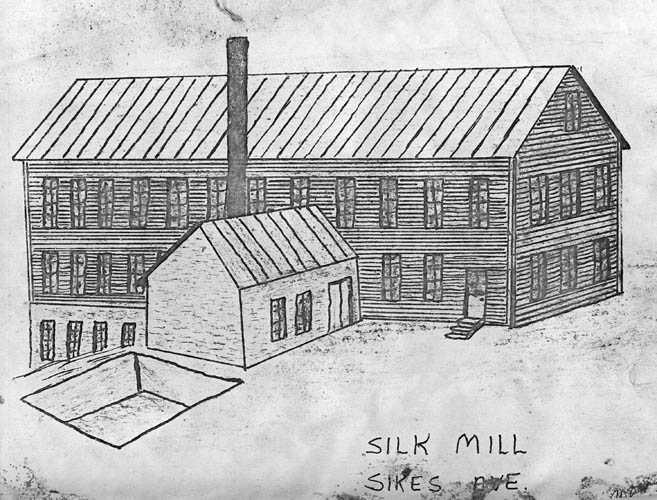
OIL PAINTING BELOW BY IRIS TEFF, BADEN LAKE, NC
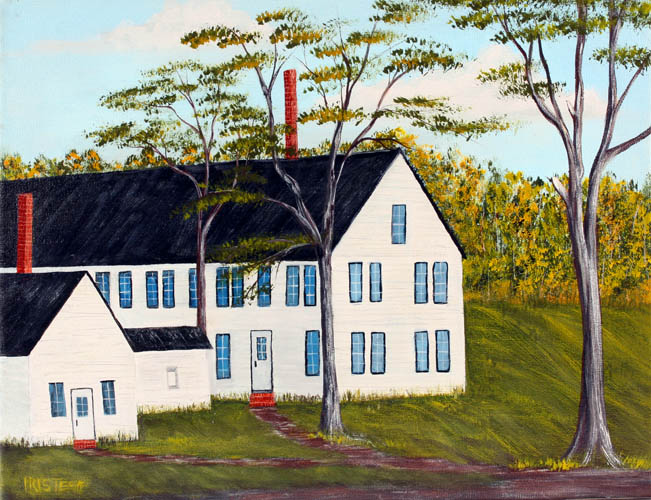
Above oil painting I commissioned Iris Teff of Baden Lake, NC to do based on
two photographs of the Singleton Silk Mill and the line drawing by J.
D. Lewis in 1976.
SINGLETON SILK MILL PHOTOGRAPH CIRCA MAY 1900
Below is an actual picture taken by Professor Charles A. Young, Astronomer of Princeton
University while doing Research on the
Solar Eclipse of May 28, 1900.
Mark Treadaway located the picture while doing his own solar eclipse research of the old
archives at Princeton University and my Sister Susan Pettigrew copied the picture from his Facebook page
and emailed it to me and I certainly do
thank Mark Treadaway for posting the picture and also for donating a hard copy to the Anson
County Library genealogy room. The picture angle in my humble opinion doesn't give the
true height perception of the ole Silk Mill as I remember it since the photograph was taken a
good distance downhill with a predominant foreground from the Silk Mill, but
then again, when we are younger things have a different visual perspective too!
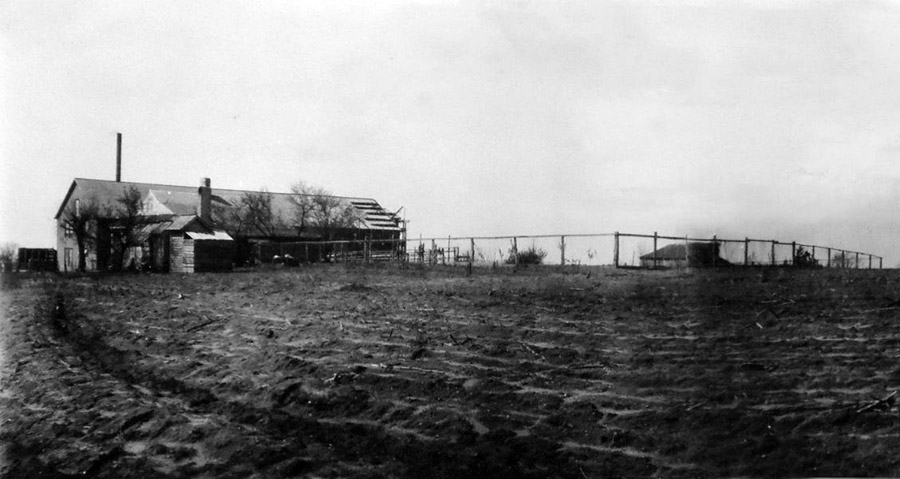
Below is a pix that Dianne Welch scanned and emailed me from the photograph
that Mark Treadaway donated to the Anson County Library which is cropped
different and shows more hue and detail. It appears the rectangular
building in front of the larger building has some type of construction going
on by the presence of a boom on the far right side of the building and they
might be in the process of finish putting tin on the roof as evidenced by
the horizontal layers with open spaces between them which is typical of tin
roof construction; just a "guess at the best":
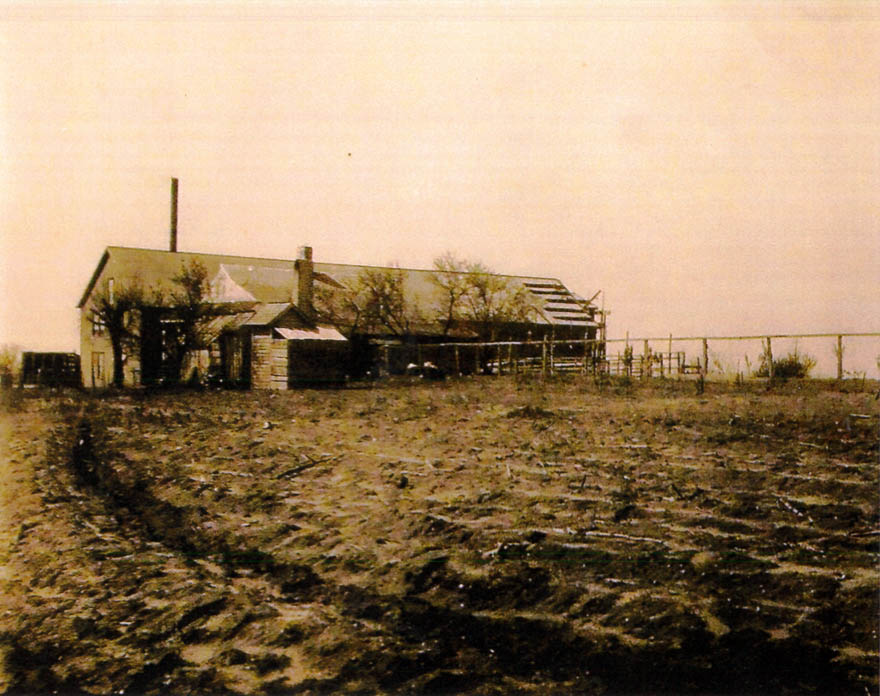
When myself, Cousin
Johnny Ray Coley (deceased) and my brother
Allen Porter
were sneaking into the unlocked building back in the middle to late 1950s and through
the middle 1960s until it was later burned down, the area wasn't
as open as in this picture. It appears that the area was freshly
plowed up to the fence line and looks like the remnants of corn stalks in
the plowed area. There is a good elevation drop depicted in the
picture from where the camera was set up to the
fence line and the only area I remember close to the Silk Mill with the above
elevation drop where the Silk Mill stood in the 1960s was facing toward
Maple Lane on the edge of the Silk Mill property. The woods back then was grown up nearly to the edge
of the building on the left and there were large trees on the above property
and no fence either. There was at least one
Catalpa aka Indian Cigar Tree on the property and I remember the
long seed pods that would hang down and eventually dry out and burst open. Young folks wanting to try their hand
at smoking, would try and smoke the dried out pods and also
smoke
rabbit tobacco in home made acorn
pipes.....grin if you must! For some reason, I don't remember the front
facade of the structure of the building and it appears there is a building
in front of the main structure, but that was over fifty-five (55) years ago. The driveway coming off Sikes Avenue going up the
incline to the Silk Mill was also
about overgrown, especially on each side of the driveway, but still passable with a vehicle and a smaller building was
located on the right hand side of the driveway and a larger building further
up the driveway if memory is correct which might have been the home of the Superintend and/or the
persons running the mill. The Stations lived in that house at one time
per Aunt Mollie Bowers and others, however the image of the structure has
faded from my memory or it was not there in the late 1950s. There were several large Walnut trees near
the old mill and this picture sure does bring back some wonderful memories
from the past. It was an amazing sight to a young kid being on
the upper level of the ole Singleton Silk Mill looking out over the
countryside taking in such a wonderful panoramic scenic view. Above photograph added on August 13, 2015.
Aunt Mollie also remembers the reservoir near the silk mill and the one
adjacent Maple Lane and stated they later covered it over with a tin roof of
which that is what I remember for both of the reservoirs. I do not
remember any well located on the silk mill property and Aunt Mollie said
they pumped water from the reservoir off Maple Lane and remembers the pipes
going up the hill to where the silk mill was located. She said there
was a well worn path going from the reservoir to the plateau where the
Singleton Silk Mill was located and definitely used since I doubt any of the
laborers owned a vehicle at that time.
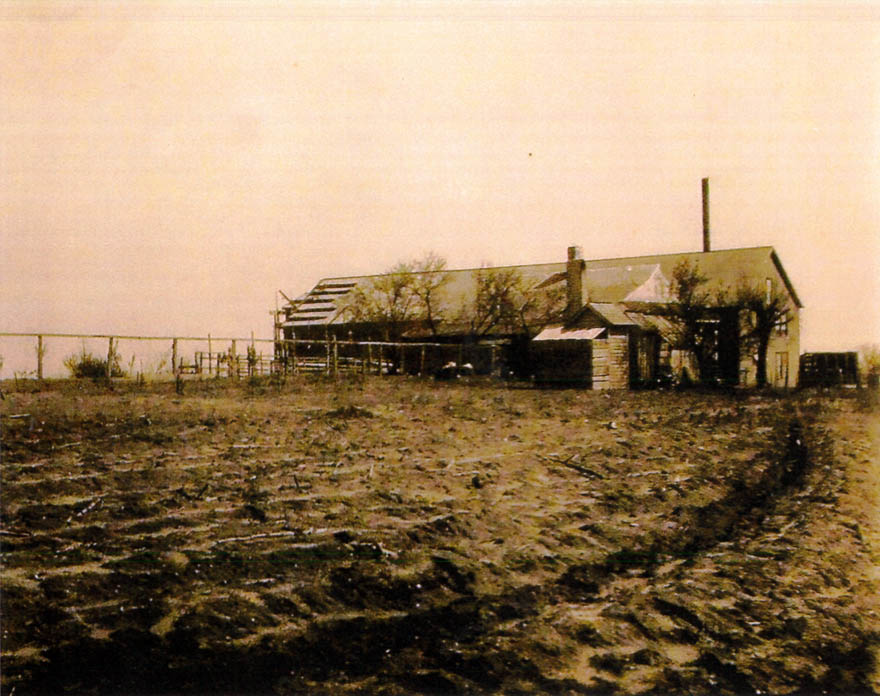
I flipped the picture horizontally and the main building facade matches the line drawing and Mary
Medley's picture more closely. I believe the negative glass or film
used to capture
the above picture was flipped when they made a print from it; in
my humble opinion.
COMMENTS MADE BEFORE RECEIVING THE 1900 PHOTO ON
08-13-15
If memory is correct, the west end of the building to the left had some type
of inside stairwell that went up to the top floor and we could look out over
the countryside. The in ground depression in front of the small
building (drawing) was a concrete and/or brick lined water reservoir which
was in the edge of the woods in the 1960s and covered with vines, etc., and still
had a metal roof over it. There were some piping that went
toward Maple Lane and there was a reservoir not too far off the road of
which it appeared they might have pumped water from it to the Silk Mill
in my humble opinion. It also had a metal cover over it and was always
filled with water; it could have been a hand dug well also. The small
building attached to the side/front of the mill and the smoke stack were not
there in the mid to late 1950s,
therefore it was torn down and removed. In one of the newspaper
archived articles in 1928 hyperlinked above, it mentions that the new owners
had repaired the old mill and I am certain the power source for the mill was
electricity versus steam power and the old power plant boilers would
definitely not be needed or any structure associated with them external of
the main building. I am not exactly sure of the orientation of the mill as its
location in relationship to Sikes Avenue at the crest of the hill. At
the time of this mill in 1888, they would have used steam power and that
smaller attached building could have been their original power plant as
evidenced by the smoke stack. Many old mills of this type had one long
power shaft that went the entire length of the mill supported on bearings and leather drive belts
were fastened together at their ends with flat metal rings or hooks where
they could be installed onto the main drive power shaft going to each bank
of machines. Imagine what kind of noise that would generate with all
those leather drive belts making that plop, plop type sound ever time the
belt made a complete revolution with the metal flat rings making contact
with the power drive shaft and the machine drive pulley and that was long
before
OSHA.
Below pix from Mary Medley's book
The History of Anson County 1750 - 1976
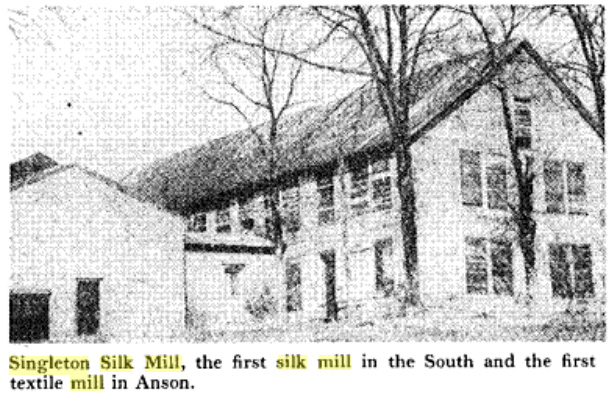
The above pix gives a more realistic visual as to the size of the structure
from ground level. As I stated earlier about the pixs posted on here,
I only remember one long rectangular building with no other structures
attached or near it in the middle to late 1950s through the mid 1960s.
SATELLITE IMAGE OF THE AREA TAKEN IN 2010
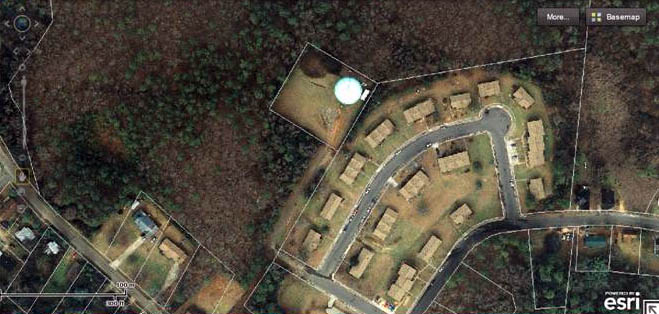
I am "guesstimating" that the Singleton Silk Mill was located somewhere near the
south east side of the water tank of which the terrain was then sloping downhill on the left hand side as per the
1900 photograph was taken and the building would be facing more parallel or
at an angle toward Sikes
Avenue. In the above satellite image; If you travel West from the
water tank you will end up behind Grandma Coley's old home place at 910
Maple Lane. Toward the end of this short story, there is a picture of
Grandma Coley and Cecil Ackerman standing near the right front portion of
the
home of Grandma Coley and off in the background you can see the
water tank that was constructed in 1968 to 1969 after the demise of the silk
mill. However, the angle of the camera lens compresses the background
in the picture making it look much closer than it actually is and also by
the size of the water tank itself. The
old driveway/road going to the Singleton Silk Mill in the 1960s was right at
the crest of the hill at the beginning of the curve in the road of Sikes Avenue in the above pix. I plan to walk that area in the near
future when the temperature cools down some and see if there is anything recognizable around the perimeter of the
current landscape.
I walked directly by the Singleton Silk Mill during the middle to late 1950s through
1964 as my short cut from Wadesboro Middle School on White Store Road and
the Wadesboro High School on Camden Road, whereas I crossed highway 74 and went down
N. Rutherford Street of which it is a steep uphill climb and crossing
Wheeler Street. I then went by the smaller City water storage tank going
onto the property of Daisy Bell Wheeler and her Mother and there was a well
worn trail through the woods that came out right below the crest of the hill
there on Sikes Avenue. I then climbed the red clay bank and/or went
up Sikes Avenue to the left (depending on the weather) about 20 yards and accessed the
old driveway toward the Silk Mill. The flat open area had several
large Walnut trees and an Indian Cigar Tree and the rest was grown over with
broom straw
until you reached the back side of the property which had various types of
pine trees and hard wood trees growing. It
didn't take too long going down the back side of the property which was all
down hill until I reached the small branch behind our home and then it was a
short up hill walk to our back yard at 910 Maple Lane. I am surprised
that my memory has failed me on the exact orientation of the Silk Mill but memory
has a way of doing that many decades later.
Aunt Mollie Bowers related to me that as a young teenager she remembers
climbing up the stairwell (circular stairs) to the top floor and she could
look out and see their home directly in front of the end which would make
the orientation of the mill with the long side more parallel toward Sikes
Avenue than with the end facing Sikes Avenue. Check this 1940
image
of a map layout of Wadesboro which shows the orientation of the Silk Mill
(A) in relationship to Sikes Avenue and the West Side Extension land (D)
owned by Jesse McKnight "Mack" Coley. UPDATED: 08-22-15.
CARR'S MOUNT PROPERTY VIEW TODAY
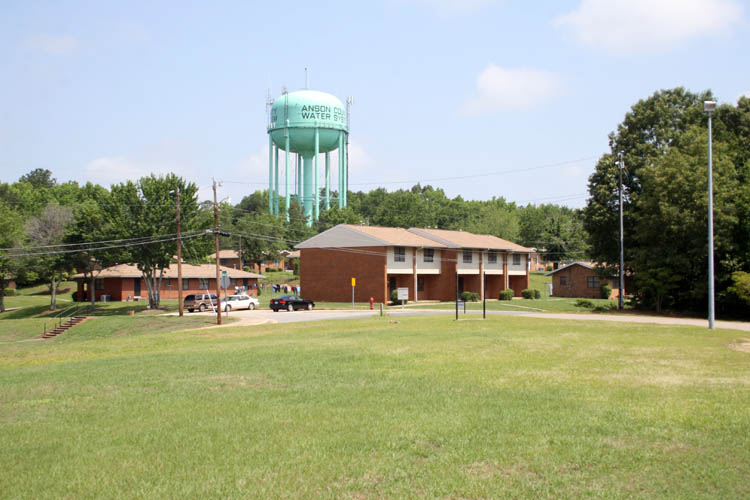
Above pix of 9.1 acres of the original Carr's Mount property that was owned by the
Singleton Silk Mill of which it is occupied by the Wadesboro Housing
Authority and a County water storage tank. The balance of the property
is owned by Dunlap & Mills, Inc.
MS. SALLY R. SMITH, GRANDDAUGHTER OF CHARLES & SARAH UREN
While doing further research at the Hampton B. Allen Library in Wadesboro,
NC on August 17, 2015, I found pictures in the Singleton Silk Mill
file kept in the genealogy room that Ms. Sally R. Smith of Berlin, MD
submitted to the library via Steve Bailey back in 2011. I wrote Ms.
Smith a letter and asked for additional information concerning the pictures
and she emailed me back on 08-22-15 whereas, "When Mr. George Singleton visited
Rose Hill (location of the mill), he brought his own bed and wash stand for
comfort. When the mill closed, he left these items. I have his bed and
my daughter has his wash stand. As I understood it, Mr. George Singleton
didn’t live at the mill house but when he came down from N.J., he would stay
at the house because he felt more comfortable there instead of the boarding
house." Ms. Sally R. Smith is the granddaughter of
Charles Uren who
replaced Robert Singleton in 1905 as the new Superintendent of the Singleton
Silk Mill and he stayed there until the mill closed in 1927. Ms. Smith
is going to take digital images of the items mentioned and other artifacts
from the Singleton Silk Mill and send digital images of them to me when time permits.
View this
clip of how silk is made.
Below is a pix of Sally Smith holding a certificate of appreciation, left in
pix and County Commissioner on the right with most of the docent group of the
Rackliffe House. I have the certificate hyperlinked
here.
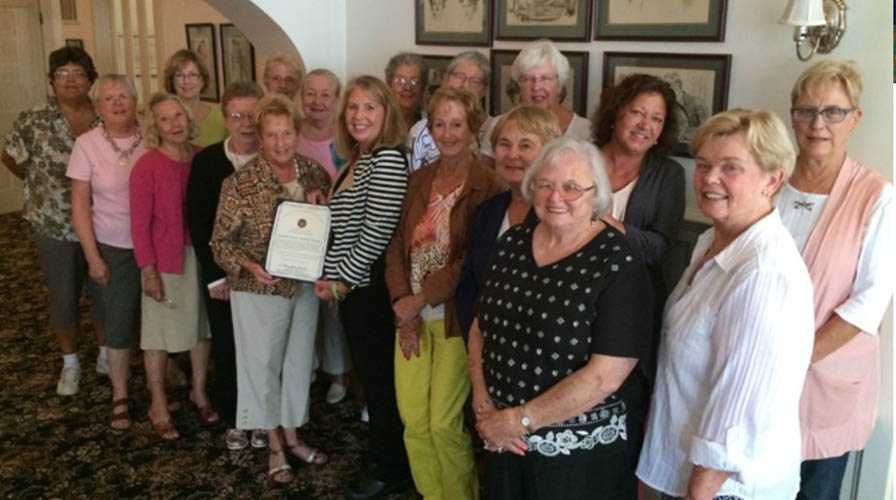
I had a wonderful chat with Sally Smith on the morning of August 26, 2015
and she is the head docent at the
Rackliffe House on Assiteague, Md. and very
much interested in genealogy and history. I look forward to receiving
the pixs from her and sharing them with others. We both are directly connected to the
Singleton Silk Mill by the way of our relatives!
Below pix of George Singleton's wash stand:
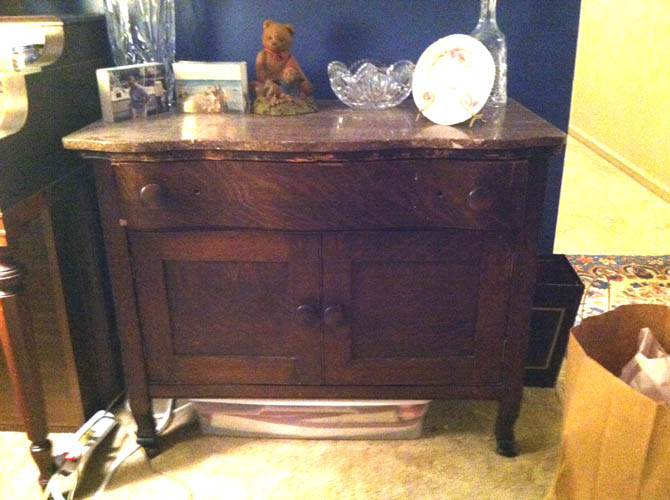
ADDITIONAL ARTIFACTS FROM THE SINGLETON SILK MILL

Above pix of George Singleton's bed that he kept at the Superintendents
home at the Singleton Silk Mill which is now in the possession of Sally
R. Smith, Granddaughter of Charles and Sarah Uren. A wonderful and
lovely piece of history! Sally Smith is a first class decorator for
sure!

Pix above of a shop vise from the Singleton Silk Mill.

Pix of the inspection loupe used by the Superintendents of the Singleton
Silk Mill for quality control.

Above a framed picture that belonged to George Singleton and was left
at the Superintendent's house there on the Singleton Silk Mill property along with his bed, night stand and other things.
A very special thank you to Ms. Sally R. Smith
and her husband Ray
of Berlin, MD for
getting those digital images to me and below a pix of them taken
on board a cruise ship on September 6, 2015:
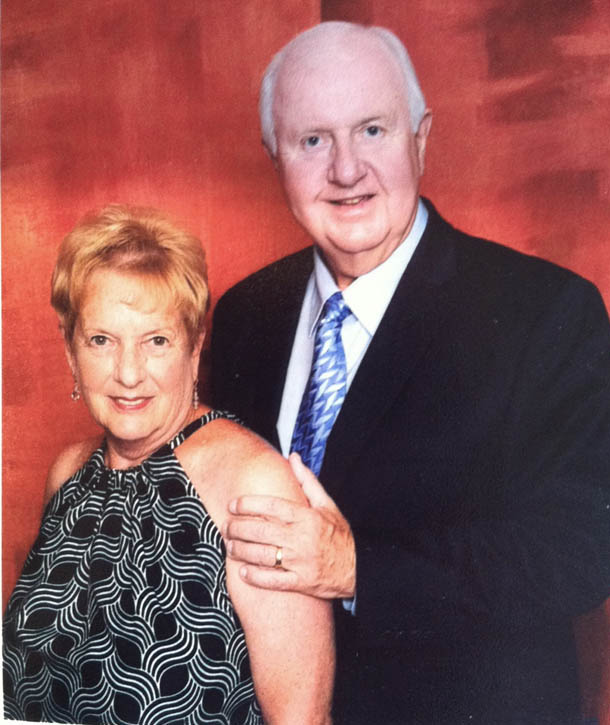
Aunt Mollie Bowers remembered the name Charles Uren (pronounced
you ren) when I last talked with
her and she stated that Grandma Coley personally knew
Charles Uren aka
"Charlie" as he
would come through the mill doing daily inspections. Grandma Coley worked at
the mill from 1902 until she married Jesse McKnight "Mack" Coley on August
21, 1919 except for a couple years when they enforced the
Child Labor Law.
ADDITIONAL REFERENCES:
1) ANNUAL REPORT OF THE BUREAU OF LABOR AND PRINTING OF THE STATE OF
NC VOLUME 14 PAGE
PAGE 184 AND
PAGE 186, BY: B. R.
LACY, COMMISSIONER Circa 1900
2) REPORT ON CONDITIONS OF WOMAN AND CHILD WAGE EARNINGS IN THE UNITED
STATES, BY: CHARLES PATRICK NEILL, GOVERNMENT PRINTING
OFFICE Circa 1911
PAGE 22
3) THE AMERICAN REVIEW OF TUBERCULOSIS VOLUME III 1919-1920 BY
EDITORIAL STAFF, EDWARD R. BALDWIN EDITOR IN CHIEF PAGE 1346
SUBCHAPTER "A RESUME OF A TUBERCULOSIS SURVEY OF A SILK MILL VILLAGE IN
NORTH CAROLINA", BY: L. B. McBRAYER
PAGE 920
MEMORIES FROM THE PAST
Fond memories still linger of the many conversations Grandma Coley and
myself had in the front living room with each of us sitting beside the
Seigler oil
heater in our own wooden rocking chair with Grandma telling me about how
things were back when the lifestyle was much different. I know many
older generation people that said they would like to go back when things
were much simpler, but Grandma Coley had no such desire because life for her
growing up was very hard and difficult. As a young girl, she had to
help support her invalid Dad and help look after the family, as her mother
was deceased. She worked 12 hour shifts as a silk winder? at the ole
Singleton
Silk Mill (Circa 1888-1927) on Sikes Avenue to help support her
family where now is located a housing development (Wadesboro Housing
Authority) and a large water tank in
the middle of the plateau or highest elevation on the property.
Grandma Coley's Father
died from pulmonary tuberculosis in 1915
having the disease for 4 years; Her Sisters, Jennie Trexler Teal
died from pulmonary tuberculosis in 1912 having the disease for 3
years and Lena Trexler
died from tuberculosis in 1911 having the
disease for 1 year. There is a high probability that Jennie and Lena
contacted the disease while working at the Singleton Silk mill since there
was an outbreak of the
disease during the time period they worked there of
which they apparently transmitted the disease to their Father John H.
Trexler. Her younger brother James Clyde Trexler
died of bilateral pneumonia and I personally
know the house they all lived in didn't have any insulation and they heated
with wood fireplaces and/or wood heaters which barely puts out enough heat
for one room, especially in frigid weather. There was no inside toilet at that time and the outhouse
was located a good distance from the house increasing the odds of getting
sick from the elements especially in cold, damp, rainy and frigid weather.
The term
slop jar was most applicable back then.
I received a copy of Ellis Thomas Trexler's
Certificate Of Death on 08-21-15, whereas
he died in 1945 from secondary anemia due to hemorrhage from bowel due to
Laennec Cirrhosis of Liver and had the
condition 3 to 4 weeks. He had an accident 5 or 6 weeks prior, but no
connection at autopsy. Aunt Mollie Bowers said Ellis didn't drink,
therefore according to the experts, children of malnutrition with a protein
deficiency usually develop the disease later on in life, especially men
between the ages of 40 to 60 and Ellis was 44 years old at his death.
In all of the tragic events of loosing her immediate family members so close
together, Grandma Coley continued to keep a positive outlook her entire life
except for the period following the death of her first son Joseph Jullian
in 1934 which I relate the full story in my
Memories From The Past short story.
Of all the hardships she endured, she kept her trust and faith in our Lord
Jesus Christ and an example for all of us to emulate.
It is a miracle any of the Trexler family members survived after being
exposed to such a highly contagious disease and it was God's will that Grandma survived,
otherwise I wouldn't be here typing this short story today. The
old silk mill was still standing in the early 1960’s and many times we would
sneak into the mill climbing up to the third story (we counted the partial
basement on one end as a story) looking out across the countryside.
There were Confederate Civil War uniforms and a sword on the 2nd floor
(middle level) and a wooden casket as well in all the debris that was stored
there. Grandma Coley related to me how she worked as a child at the
silk mill until the
Child Labor Law was locally enforced.
She started to work when she was eight (8) years old and when they enforced
the above Child Labor Law, she had to stay out of work a couple years until
she was twelve (12) years old and the year would be 1904 if my GED
math is working. She said she wore shoes until the soles would
literally fall off and would fasten the soles of the shoes in place with
cord or wire and the walk to the Singleton Silk Mill which was mostly uphill
either by the road (Maple Lane to Sikes Avenue) or short cut through the
woods and about one half mile distance. The supervisors at the Silk
Mill showed no mercy to the child workers and would punch them in the side
with a stick if they were caught dozing off and they were expected to work like adults. Can you
imagine what it would be like to work as a young child under those
conditions and wear shoes that offered no warmth or protection from the
elements in inclement weather such as snow, ice and rain traveling 1/2 mile
to and from work while going to the Singleton Silk Mill which was mostly
uphill for more than half the way?
Aunt Mollie Bowers told me that Grandma Coley stated that a water bucket was
brought around to the employees aka operatives and they used the same dipper
to drink water from the bucket and that definitely was not healthy with such
a high rate of tuberculosis as documented by the survey done in 1915
compiled over a twenty (20) year study of which the tuberculosis rate was
eight (8) times the national average in the West Side Extension (silk mill
village).
Leaving on a positive note, The Singleton Silk Mill
Mfg. Co. did provide jobs and
housing for families at a time when there was very little industry here in
Wadesboro, NC and the income from those jobs sustained entire families until
they could better themselves. Sometime after 1923, The Wadesboro Mfg.
Co. was operational bringing in the start of a new industry to the county,
with cotton replacing the dead and/or dying silk industry and they also
suffered a set-back during The Great Depression Era, however it is still going
strong today with annual revenues between 20 to 50 million dollars.
I have more personal accounts and stories related to my Grandma Della Coley
on my web page titled:
Memories From The Past. Below
is a picture of my Grandma Coley and her first son Joseph Julian Faulkner
around the time she married Jesse McKnight "Mack" Coley in 1919:
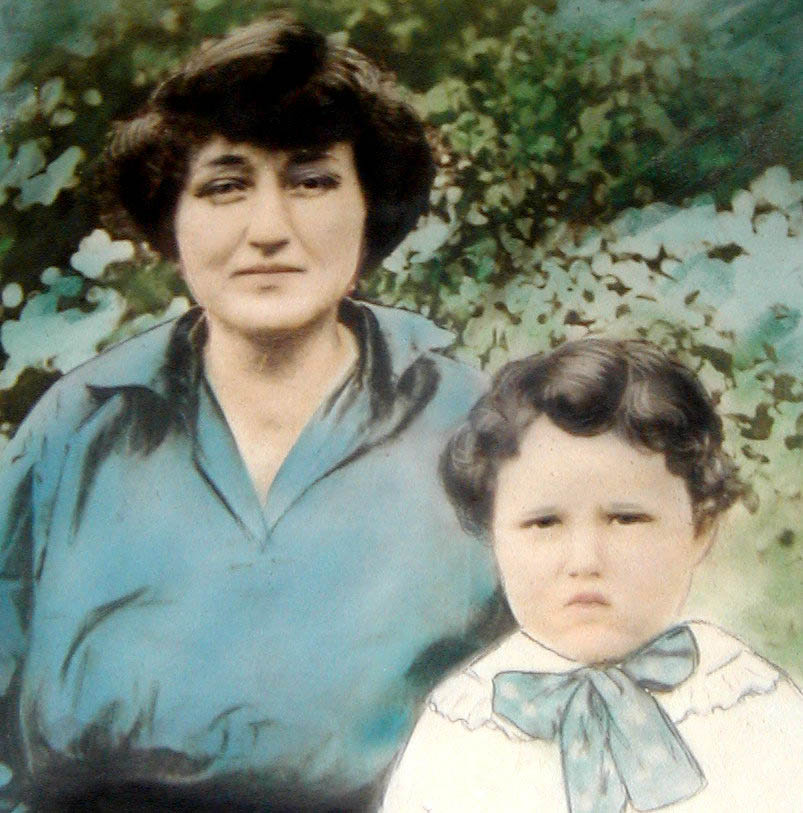
In closing, as long as there is someone left to document the story, tell the
tale, events
and memories from the past will continue to live on, but it is somewhat
paradoxical, being sad and yet happy
at the same time to relive
those events in one's
mind’s eye when so many of our love ones are gone before us and time is
definitely not waiting on any of us. God Bless Each Of You!
Web published by Bill aka Mickey Porter on 08-26-15 and updated on 08-27-15, 08-27-15, 08-28-15, 08-29-15,
09-04-15, 09-05-15, 09-19-15, 09-22-15, 09-24-15, 09-26-15, 09-28-15,
09-30-15, 10-21-15 and 10-22-15.
ABOUT THE AUTHOR
I was born William McKnight Porter on February 7, 1946 in Wadesboro, North
Carolina, the first of four children. I graduated Wadesboro High
School in 1964 and enlisted in the US Navy, August of that year.
Following boot camp in Great Lakes, Illinois, I attended a six month
Radioman Class A school in Bainbridge, Md. I was transferred to
Morocco, Africa at a communications relay station and worked at the
communications receiving site which handled communications to the 6th fleet
ships.
After two years in Morocco, Africa, I was transferred to the Naval Air
Station in Norfolk, Virginia and specialized in Crypto and our group was
called Manned Spacecraft Recovery Force Atlantic TF-140 and participated
with the NASA program. I attended the unmanned Apollo 6 mission in
Cape Canaveral, Florida in 1968 and stayed a week before and a week after
the April 4, 1968 launch.
While still in the US Navy at the Naval Air Station in Virginia, I married
Joyce Adcock of Wadesboro, NC my grade school sweetheart and we have been
married for over fifty-five (55) years and she is still the love of my life.
We have one son, two daughters, five grandsons and one granddaughter.
After a four year tour of duty with the US Navy in 1968, my bride and myself
returned to Wadesboro, NC and I went to work with the North Carolina
Telephone Company in Marshville, NC and installed and repaired two-way
radios and mobile telephones and later transferred to the Wadesboro office
installing and repairing special communications equipment. During that
time, I formed a mail order business for stringed musical parts and
accessories and cutting and inlaying Mother of Pearl, Abalone Pearl and
fabricating pre-war reproduction metal parts, repairing stringed
instruments, etc. I sold the business in 1978. I also attended
the local community college and majored in Business Administration and
Industrial Management earning a two-year degree in both.
In 1979, I went to work with the N. C. Department of Correction as a
Correctional Officer and over a thirty-three (33) year career had a variety
of duty assignments including: Administrative, Transportation, Clothes House
Supervisor, Key and Lock Control Officer, Firearms Instructor, General
Instructor, Unarmed Self-Defense Instructor, Firing Range Officer and Armory
Officer, created and maintained data bases for the inventory and purchase of
associated equipment and supplies, etc.
In 1986 while working with the NCDOC, I formed W. M. Porter Co., Inc. and
manufactured metal climbing tree stands and awarded two US Patents,
4,952,668 and 5,167,298 and sold the company and rights to the
tree stands in 2000.
I retired in 2012 and enjoy many hobbies including, photography both nature
and food, hunting; e.g., archery, firearms, muzzleloading aka black powder,
fly fishing and regular fishing, wood working, occasionally building a
musical instrument, banjo and Dobro and thumping on their strings.
When the internet became of age, our son William, Jr. helped me get up to
speed and create my own website of which I write short stories, hunting
stories and have a Recipe page complete with a pictorial essay of most of
the recipes that I do. Food styling is another hobby too!
I give God through Jesus Christ our Lord and Savior the praise, glory and
honor in all things.
This short story is dedicated to the memory of my Grandma Della Coley!
LEAVING ON A
SPIRITUAL NOTE
If you do not know Jesus Christ as your Lord and Savior, please take
this moment to accept him by Faith into your Life, whereby Salvation
will be attained.
Ephesians 2:8 - 2:9 8 For by grace are ye saved through
faith; and that not of yourselves: [it is] the gift of God: 9 Not of
works, lest any man should boast.
Hebrews 11:1 “Now faith is the substance of things hoped for,
the evidence of things not seen.”
Romans 10:17 “So then faith cometh by hearing, and hearing by
the word of God.”
Open this
link about faith in the King James
Bible.
Romans 10:9 “That if thou shalt confess with thy mouth the
Lord Jesus, and shalt believe in thine heart that God hath raised him
from the dead, thou shalt be saved.”
Open this
link of Bible Verses About Salvation,
King James Version Bible (KJV).
Hebrews 4:12 “For the word of God is quick, and powerful, and
sharper than any two edged sword, piercing even to the dividing asunder
of soul and spirit, and of the joints and marrow, and is a discerner of
the thoughts and intents of the heart.”
Romans 6:23 “For the wages of sin is death; but the gift of
God is eternal life through Jesus Christ our Lord.”
Romans 3:23 “For all have sinned, and come short of the glory
of God;”
Micah 6:8 “He hath shewed thee, O man, what is good; and what
doth the LORD require of thee, but to do justly, and to love mercy, and
to walk humbly with thy God?”
Philippians 4:13 "I can do all things through Christ which
strengtheneth me."


